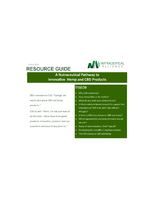NREL collaborates with Colombian oil firm.
Share:
Press Release Summary:
NREL is working with Ecopetrol, the largest oil company in Colombia, to process the residue from sugar cane and palm oil harvesting into fuel ethanol for blending with gasoline. Cooperative Research and Development Agreement between NREL and Ecopetrol aims to optimize conversion process for bagasse and to analyze economic case for commercial production of biofuel from these materials. It will also include some limited study on palm rachis — the material left over after palm oil production.
Original Press Release:
NREL and Colombian Oil Firm Unlocking Agricultural Waste Feedstocks for Biofuel
Collaboration with Ecopetrol examines converting sugar cane bagasse to biofuel
The Energy Department's National Renewable Energy Laboratory (NREL) is working with Ecopetrol, the largest oil company in Colombia, to process the residue from sugar cane and palm oil harvesting into fuel ethanol for blending with gasoline.
The Cooperative Research and Development Agreement (CRADA) between NREL and Ecopetrol aims to optimize the conversion process for bagasse (the material left over after the sugars are removed from the sugar cane) and to analyze the economic case for commercial production of biofuel from these materials. The CRADA will also include some limited study on palm rachis -- the material left over after palm oil production.
The $2.3 million 18-month project is being funded by Ecopetrol, which turned to NREL for its expertise on conversion of biomass, its compositional analysis and techno-economic analysis capabilities, and NREL's unique facilities. NREL has a pilot plant at its Golden, Colo., campus that has conversion capabilities from lab scale to pilot scale, processing up to one ton per day of biomass – everything from corn stover to switchgrass and poplar trees.
Colombia has an abundance of biomass in the form of sugar cane. The rainfall patterns in the region near the Pacific Coast where the sugar is grown for the biofuels industry allows the crop to be harvested all year round, but there's not much room for expansion.
Sugar cane also is grown farther east, but because of incessant rain from April to August, it can only be harvested eight months a year. The plant spoils quickly if the sugars aren't squeezed out. But the bagasse – the leftovers that comprise a majority of the plants' mass and give it rigidity and structure – can be stacked and stored for a long time after the juice is removed and washed out of the green grass stalk.
That bagasse currently is burned to produce steam that drives turbines for electricity, but Ecopetrol is hoping to get more value out of it than that.
The hope is that commercial conversion facilities and employees can be kept busy all year round by processing the bagasse during the rainy season when it's too wet to get to the fields and harvest the sugar cane. It's more challenging to break down the cellulose in the bagasse than the sugar-rich juice, but if the conversion process is successful, the bagasse can be processed into a biofuel.
There are plenty of reasons to be optimistic the plan will work, said Rick Elander, Biochemical Conversion Manager at NREL's National Bioenergy Center.
For one thing, Ecopetrol already has in place a commercial facility for converting sugarcane juice into fuel-grade ethanol. The fermentation and distillation equipment at that facility could also be used to hydrolyze the bagasse and ferment the resulting sugar into additional ethanol, increasing the output of the facility and enabling year-round operations. It would only have to add the pretreatment process and tweak the "knobs and dials" to optimize the operation, Elander said. That's an area of expertize at NREL – breaking down the feedstock so it's ready for enzymes.
NREL is a world leader in the technology that breaks down various non-food feedstocks to get them ready for fermentation. "Nature makes it much more difficult to break those bonds that give the plant rigidity and strength," Elander said. "But we know how to liberate those sugars and we're working on doing it as quickly and cheaply as we can."
"This can be a great opportunity to leverage off infrastructure that's already bought and paid for, which would otherwise be sitting there idle," Elander said. "It will take a little additional investment by Ecopetrol on the front end.
"We're going to help them figure out if the performance they're getting from the available lignocellulosic feedstocks is going to make economic sense," Elander said. "On paper, you could make a pretty good case for it because they're not starting from scratch. They have a facility and infrastructure in place and they have that captive bagasse feedstock that is already at the facility."
NREL's mission includes developing and demonstrating technology and easing its transfer to the private sector. The Energy Department funded NREL's Integrated Biorefinery Research Facility with the intention of it being used by this developing industry to bring successful technologies to market. Partnerships like the one with Ecopetrol enhance knowledge and can help with overall U.S. goals of reducing greenhouse gases and reducing reliability on foreign sources of oil, Elander said. The experience gained in processing these two biomass feedstocks will be directly applicable to other feedstocks prevalent in North America.
NREL is the U.S. Department of Energy's primary national laboratory for renewable energy and energy efficiency research and development. NREL is operated for the Energy Department by the Alliance for Sustainable Energy, LLC.
Visit NREL online at www.nrel.gov
Media may contact:
William Scanlon
303-275-4051
William.Scanlon@nrel.gov




